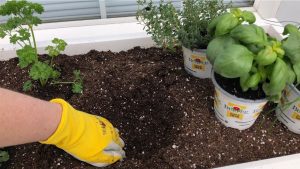Planting your Vegetable Starts from Seeds
If you are planting a garden this spring, you might consider growing your own starts from seeds. There are a number of advantages in doing so. You can buy a seed packet for $3-$5 that could yield as many as 20 plants or more vs. that same cost for one plant. First, select your seeds. You can do this online or get them at the nursery. Either way, you will have more options, including disease-resistant varieties. Your seedlings will also get acclimated to your environment right from the beginning. Consider what you and your family will eat, and select your seeds.
Now, choose a location for the starts. A south-facing widow with a large sill would be ideal if you want to start them indoors. To prevent “leggy” starts, install a grow light suspended about 2-4 inches above your plant tops and run it for 12 to 16 hours. This will result in hardy seedlings with sturdy stems. In the sprouting stage, your containers will all fit on the sill, but have a plan for where to keep them once you transfer them to larger pots for further root development. The time for this is shortly after the seedlings develop their second set of leaves. If you have a greenhouse, this is an ideal place to keep your plants once they are in the larger pots. You may need to put a small heater in there to keep the temperature just above freezing at night, so be sure your greenhouse is close enough to an electrical source to facilitate this need.
Gardening supplies
You won’t need to purchase pots for starts if you make use of various empty containers, such as cardboard cylinders from toilet paper rolls by folding one end closed, egg cartons and even eggshells. Once the plants get bigger, they can be transplanted into larger emptied food containers. An adequate greenhouse can be just a few shelves under a small, clear, covered frame to keep your plants warm. Many of this type can be purchased for under $50, just be careful where you put them. High winds can flatten sturdy-looking housing in minutes. Anchoring can help, but the housing would have to have a sturdy frame. Shop around to get a heat mat to help seeds germinate, and a grow light with an outdoor light spectrum, and a small greenhouse for just under $100.00. Seeds and potting soil will add a little more. If you already have gardening tools, you are ready to go.
There are timing considerations to make for this project, including what to start when. For most plants, get your seedlings going 2 months before the last frost, for eggplants, squash, cucumbers and tomatoes, you will want to plant the seeds 2 months before the soil warms, usually around the end of May. So, plant these sometime in March. Root vegetables must be planted directly into the garden beds.
Moisten your soil before filling your starting pots. A shallow mixing tray, such as an unused kitty litter box, will do. Fill the pots, but don’t compress the soil mix. Read the seed depth instructions on the packet and make indentations with your little finger and you are ready to plant the seeds, using dry hands. Add just a sprinkling of loose soil over the planting hole and mist lightly one more time. Move your planted seedling to the area you prepared, safe from drafts. Add a plant heating pad and keep seedlings moist, but not saturated and enjoy watching them grow. Happy gardening!
View more information here.
Wendy Kubow is a University of California Cooperative Extension Master Gardener of Calaveras County.
UCCE Master Gardeners of Tuolumne and Calaveras Counties can answer home gardening questions. Call 209-533-5912 or fill out our easy-to-use problem questionnaire here. Check out our website here. You can also find us on Facebook.

